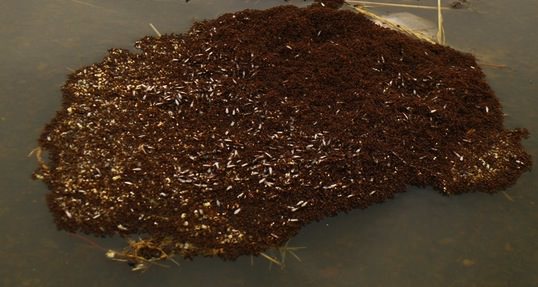When an area floods, fire ants will work together to create a massive, waterproof raft out of their bodies to stay alive. Now, scientists have taken a closer look at this raft-building behavior, revealing how these industrious insects manage to stay afloat.
Fire ants grasp onto one another with their mandibles and legs at a force of 400 times their body weight in order to create these rafts. Yet scientists wanted to see the strongest parts of the structure and how exactly they connect. That’s why the scientists froze ant rafts and then scanned them with a miniature CT scan machine.
“Now we can see how every brick is connected,” said Georgia Tech Assistant Professor David Hu. “It’s kind of like looking inside a warehouse and seeing the scaffolding and I-beams.”
He found a lot of beams.
On average, each ant in a raft connects to 4.8 neighbors. Ants have six legs, but using their claws, adhesive pads and mandibles, each critter averages nearly 14 connections. Large ants can have up to 21. Out of the 440 ants scanned, 99 percent of them had all of their legs attached to their neighbors. The connectivity produces enough strength to keep rafts intact despite the pull of rough currents.
Hu and his team also noticed that the insects use their legs to extend the distances between their neighbors.
“Increasing the distance keeps the raft porous and buoyant, allowing the structure to stay afloat and bounce back to the surface when strong river currents submerge it,” said Nathan Mlot, a Georgia Tech graduate student in the George W. Woodruff School of Mechanical Engineering who worked on both studies.
Mlot and the rest of the research team also found that smaller ants tend to fill in the spaces around large ants. This keeps water from seeping in and prevents weak spots in the raft. The insects, large and small, arrange perpendicularly rather than parallel. This adds to the adaptability of the raft, allowing it to expand and contract based on the conditions. The same is true when ants build towers and bridges for safety and survivability.
One thing the CT scan can’t solve, however: how the ants know where to go and what to do. Their cooperation is a mystery the research team hasn’t figured out – yet.
“Fire ants are special engineers,” said Hu. “They are the bricklayers and the bricks. Somehow they build and repair their structures without a leader or knowing what is happening. They just react and interact.”
Better understanding of this phenomenon could lead to new applications for people and machines. For instance, Hu envisions robots than can link together to build larger robots or bridges made of materials that can self-repair.
“If ants can do it, maybe humans can create things that can too.”
Agencies/Canadajournal

 Canada Journal – News of the World Articles and videos to bring you the biggest Canadian news stories from across the country every day
Canada Journal – News of the World Articles and videos to bring you the biggest Canadian news stories from across the country every day

